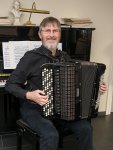xocd
Active member
I studied piano for several years with a very technical teacher (Taubman Technique). I can play fast and legato scales on the piano without using the pedal. I am having a hard time translating this technque to the accordion because, I believe, the angle between the forearm and the keyboard is different on the two instruments. For example, when I play an ascending scale with the right hand on the piano my elbow is further to the right (towards the high notes) than my hand; the thumb can move under the palm and ahead of the fingers easily. On the accordion (unless one is playing the very lowest notes) I cannot obtain this angle (the elbow is higher than the hand.) The joint at the base of my thumb starts hurting when I try to use my piano technique. I end up "walking" the keyboard with my fingers (reminiscent of early keyboard technique, perhaps).
I wonder if this is purely an anatomical quirk of mine (natural lack of flexibility?) or perhaps the accordion technique is different. Is this something you have experienced? How do you play scales?
Thanks,
I wonder if this is purely an anatomical quirk of mine (natural lack of flexibility?) or perhaps the accordion technique is different. Is this something you have experienced? How do you play scales?
Thanks,

